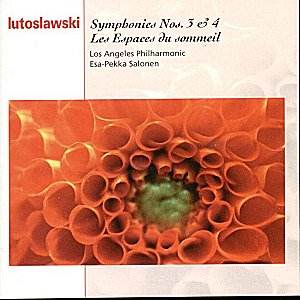This
has already proved to be something of
a modern classic of a recording. The
original CBS issue, which came out in
1987, was followed by a reissue seven
years later and now, nearly a decade
on, here it is again in Sony’s Essential
Classics series. Sony has taken the
opportunity to revamp their previously
minimal documentary details, adding
recording dates and locations to this
latest batch of reissues and that’s
more than welcome news.
As
are the performances. His last work,
the Fourth Symphony receives a reading
of genuine profundity and depth. Opening
with such intimacy and reflective lyricism
the line soon becomes more assertive,
with block interjections, all the while
illuminated by percussive glint and
sectional colour. The ear is aware of
the constant motion of the music and
its felicity of conjunctions (the string
figuration, the piano part, the scurrying
high winds, the important almost personalised
role the trumpet plays) whilst never
losing the greater symphonic picture.
In the central panel of this one-movement
work the muted series of dynamics adds
great weight to the reflective paragraphal
points. When the big climaxes come they
are excellent judged by Salonen who
has the measure of both reflection and
refraction in this symphony. His summoning
up of the decisive, percussive, brass
punctuating final moments is disquieting,
abrupt and moving.
The
Third Symphony again opens with a slow
introduction. This is a longer work
than the Fourth but there is also a
powerful concision of symphonic argument
at work here, rich in orchestral incident
and a toccata-like drama embedded in
it. I like the way Salonen brings out
the almost-rudery of the trombone and
the powerful climax. The sound quality
is unchanged from previous issues. As
for opposition, well Lutosławski
wrote the work for the Chicago Symphony
and Solti who premiered it in 1983.
In 1992 the orchestra took it into the
studios with Daniel Barenboim and theirs
is slightly preferable to this recording
– not least for the string weight and
the tighter control Barenboim exercises.
Les Espaces du sommeil was taken into
the studio a decade after it had been
written. The only negative note about
this reissue is that Sony hasn’t provided
the poem – Robert Desnos’ poem may be
a surrealistic affair but it would have
been good – to put it politely – had
new listeners been able to read the
text and listen to the composer’s complex,
never straight-forward response to it.
This performance is strong on atmospheric
word painting, Shirley-Quirk’s evocative
and serious singing, the subtle orchestration,
a predilection for held string chords,
constant inflection of the line, and
a superbly graded set of climaxes.
If
you missed the earlier opportunities
to acquaint yourself with these towering
statements you should do so now, without
delay. The relative superiority of the
Chicago Third shouldn’t put you off
this laudable selection.
Jonathan
Woolf
